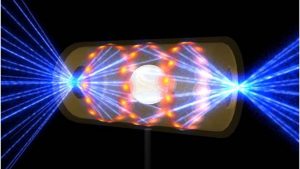In 1964, American inventor and television pioneer Philo Taylor Farnsworth invented a small nuclear fusion device. And although funding issues eventually became the demise of his research into the promise of fusion, his discovery marks the beginning of what now looks like nothing short of a renewable energy revolution, as we move one giant step closer to Stephen Hawking’s dream that nuclear fusion will “become a practical power source.” The National Ignition Facility (NIF), the world’s largest and highest-energy laser, located at the Lawrence Livermore National Laboratory in Livermore, California, has taken a major leap toward that goal.
According to Science Magazine, “ . .a single laser shot sparked a fusion explosion from a peppercorn-size fuel capsule that produced eight times more energy than the facility had ever achieved: 1.35 megajoules (MJ)—roughly the kinetic energy of a car traveling at 160 kilometers per hour. That was also 70% of the energy of the laser pulse that triggered it, making it tantalizingly close to “ignition”: a fusion shot producing an excess of energy.”

To grasp the significance of this advancement, it’s important to understand the advantages of nuclear fusion, vs. nuclear fission. According to the U.S. Department of Energy, while both fusion and fission are nuclear processes that produce massive amounts of energy from atoms, fission occurs when a neutron slams into a larger atom, forcing it to excite and spilt into two smaller atoms, while fusion happens when two atoms slam together to form a heavier atom, the same power dynamic that fuels our Sun.
The most important distinction between these two processes, beyond the fact that fusion produces significantly more energy, is that it does not produce highly radioactive products like fission does, making the process more environmentally and human-friendly.
According to ITER, an organization that oversees a large, international collaborative initiatives to explore the possibilities of fusion energy sources, “Fusing atoms together in a controlled way releases nearly four million times more energy than a chemical reaction such as the burning of coal, oil or gas and four times as much as nuclear fission reactions (at equal mass). Fusion has the potential to provide the kind of baseload energy needed to provide electricity to our cities and our industries.”
The basic limiting factor of fusion has always been its efficiency. To be efficient, fusion would need to produce significantly more output energy than input energy, or the energy needed to start, or “ignite” the process. This is why the 70% mark, up from the 3% mark of earlier trials, is a game-changer. Michael Campbell, director of the Laboratory for Laser Energetics (LLE) at the University of Rochester said this achievement, “proves that a small amount of energy, imploding a small amount of mass, can get fusion. It’s a wonderful result for the field.”
To outsiders, the process followed by the NIF team is the stuff of science fiction. The BBC News website explains it this way:

“In a process called inertial confinement fusion, 192 beams from NIF’s laser – the highest-energy example in the world – are directed towards a peppercorn-sized capsule containing deuterium and tritium, which are different forms of the element hydrogen. This compresses the fuel to 100 times the density of lead and heats it to 100 million degrees Celsius – hotter than the centre of the Sun. These conditions help kickstart thermonuclear fusion.”
The bottom line is that once scientists are able to consistently and efficiently start ignition, we can create a reliable energy source. Omar A. Hurricane, Chief Scientist for the Inertial Confinement Fusion Program at the Lawrence Livermore National Laboratory (LLNL) put it this way: “Ignition is a tipping-point in the fusion process where the fusion heats itself and overwhelms all the cooling losses that can occur. Once this happens a feedback process is generated where heating creates more fusion, which creates more heating, which creates more fusion, and so on.”
Much like the Wright brothers, who discovered the correct wing shape and angle to achieve lift, or a positive “net energy” that allows for takeoff and flight, the idea behind nuclear fusion is to create a “net energy” product that far exceeds the energy needed to ignite it, a sort of energetic “tipping point.” The experiment by NIF gets us a little bit closer to that tipping point, if we can boost the efficiency markedly.
As Brett Rampal, the Director of Nuclear Innovation at the Clean Air Task Force, an energy policy think tank said, “The current experiment produces a large amount of power … but only for a very short time … and as yields increase, experiments like this will produce more power for longer durations, important steps on the road to commercial power production which would require net positive power production for long durations of time.”
There is, however, a model of nuclear fusion that may, pardon my pun, shed some light on this nuclear power dream: stars. Stars are amazing energy production machines that “. . .spend most of their lives repetitively compressing two hydrogen atoms into a single helium atom – plus a lot of energy, which is released as light and heat.” The key, then, is to create a scalable nuclear fusion reaction much like the Sun, but in a controlled, safe environment.
There are, however, several barriers we have to overcome in order to turn this dream into a reality, namely issues with confinement and replication. As the International Atomic Energy Website explains, “While conditions that are very close to those required in a fusion reactor are now routinely achieved in experiments, improved confinement properties and stability of the plasma are needed.”
In other words, we need to be able to create miniature suns or at least the conditions under which suns operate. But as the old adage goes, this is “easier said than done.” The LLNL points out that “[R]eplicating the extreme conditions that foster the fusion process has been one of the most demanding scientific challenges of the last half-century.”
Once we determine a way to predictably harness, confine, and control the nuclear fusion process, we will be on track to creating a reliable, highly efficient energy source. Prof. Jeremy Chittenden, co-director of the Centre for Inertial Fusion Studies at Imperial College London, is optimistic, stating, “Far higher fusion energies can be achieved through ignition if we can work out how to hold the fuel together for longer, to allow more of it to burn. This will be the next horizon for inertial confinement fusion.”
Another hurdle concerns the efficiency of the nuclear fusion power process as a whole, specifically the use of magnetic fields and the types of materials composing the coils, the endpoint of nuclear fusion that generates the energy that would be distributed by a nuclear plant. The authors of the article FELT-CARBON-CARBON COMPOSITE/COPPER BRAZED STRUCTURES FOR ACTIVE COOLING PLASMA FACING COMPONENTS offer the following insight:
“An important difference between magnetic and inertial confinement is the magnetic field. Most magnetic-confinement experiments use copper coils cooled by water. When scaled up to ITER size, copper coils would consume a large fraction of the electricity generated by the power plant, and the net output of the plant would be reduced. The solution is to use superconducting coils—made from special materials that, when cooled to very low temperatures, offer no resistance to an electric current. Once energized, a superconducting magnet can run continuously, and electricity is required only to run the refrigerator that keeps the coil at the low temperature.”
The upshot of all of this is that once we find a way to effectively and efficiently confine, replicate, and release nuclear fusion energy, we are potentially on the way to a limitless supply of clean, renewable energy. In fact, ITER states, “Fusion fuels are widely available and nearly inexhaustible. Deuterium can be distilled from all forms of water, while tritium will be produced during the fusion reaction as fusion neutrons interact with lithium. (Terrestrial reserves of lithium would permit the operation of fusion power plants for more than 1,000 years, while sea-based reserves of lithium would fulfill needs for millions of years.)”
Moreover, we could finally remove ourselves completely from a carbon-based system, and in the process, drastically reduce toxic air emissions, creating a sustainable, green future that will not only change how we create energy but substantively transform our society as well. Taylor Tyler, an American nuclear physics enthusiast and science advocate who at age 14 achieved nuclear fusion using an inertial electrostatic confinement (IEC) device, shares the following vision:
If people are able to generate their own energy through a LENR device that costs a few hundred dollars, the need for oil, natural gas and power grids will soon disappear, and power companies could become obsolete.
Once worldwide implementation on a large scale occurs, governments could lose revenue from related tax collection, OPEC and its resource extraction would “become a historical footnote,” and the U.S. government stands to lose all foreign dependence on the petrodollar.
Business owners could drastically reduce overall energy costs, space exploration could be achieved without need to refuel, environmental effects from energy production could be eliminated, and humanitarian aid could be provided much more easily to those in need…
Or as the jazz great Louis Armstrong said, “What a wonderful world.”
At Newsweed.com, we adhere to three simple principles: truth, balance, and relatability. Our articles, podcasts, and videos strive to present content in an accurate, fair, yet compelling and timely manner. We avoid pushing personal or ideological agendas because our only agenda is creating quality content for our audience, whom we are here to serve. That is why our motto is ”Rolling with the times, straining for the truth.”
Your opinion matters. Please share your thoughts in our survey so that Newsweed can better serve you.
Charles Bukowski, the Los Angeles beat poet that captured the depravity of American urban life once said, “There is something about writing poetry that brings a man close to the cliff’s edge.” Newsweed is proud to stand in solidarity and offer you a chance to get close to the cliff’s edge with our first Power of Poetry Contest. Are you a budding bard, a versatile versifier, a rhyming regaler? Do you march to the beat of iambic pentameter, or flow like a river with free verse? If so, here’s your opportunity to put your mad poetic chops to the test. Enter our poetry contest for bragging rights and an opportunity to win some cash!






